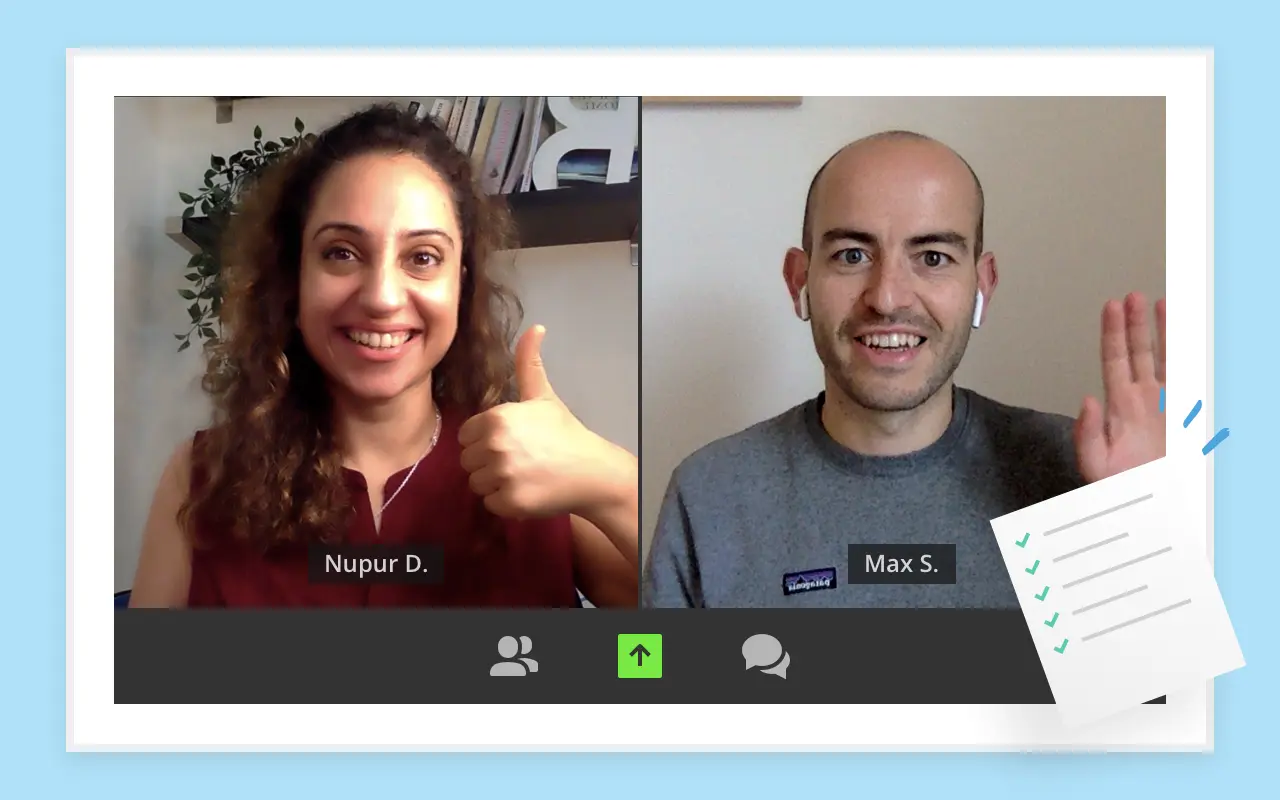Negotiating your product manager offer can feel uncomfortable and stressful. But going through this short-term pain is worth it. As an example, getting a $50k increase is common at the L5 level if you negotiate well.
We’ve put this step-by-step guide together to help you negotiate a better offer by yourself. Here are the steps you should take:
- Understand the compensation structure
- Get product manager compensation benchmarks
- Find weaknesses in the initial offer
- Send a counteroffer email
- Hold your ground
- Get expert help (optional)
If you know a PM recruiter, we highly recommend getting their help to negotiate your offer in addition to reading this guide. After all, this is part of their day-to-day job, and they’re a professional at it.
If you don’t know anyone and would still like to make sure you’re negotiating the best possible offer, then make sure to check out our PM salary negotiation coaches. They negotiate daily as recruiters and hiring managers and are therefore extremely comfortable with the process.
Let’s get started!
Click here to book a session with a salary negotiation expert
1. Understand the compensation structure↑
The different components of a product manager offer depend on the size of the company, but they will generally have the following:
- Base salary
- Stock options (RSUs)
- Signing bonus
- Performance bonus
- Equity refreshers
- Perks and benefits
- Other add-on components
We looked at the salary data for a product manager on Levels.fyi, across 8 companies (Meta, Google, Amazon, Uber, Microsoft, DoorDash, Walmart, and Salesforce) in their San Francisco Bay Area locations.
Here’s what we gleaned: based on the range and variance of the declared components, the most negotiable component tends to be the stock options, or more commonly referred to as Restricted Stock Units (RSUs).
Let’s take a look at the L5 PM salary at Meta, Google, and Amazon as an example (in the graphs, the taller the blue block, the more variance and therefore the greater room for negotiation):
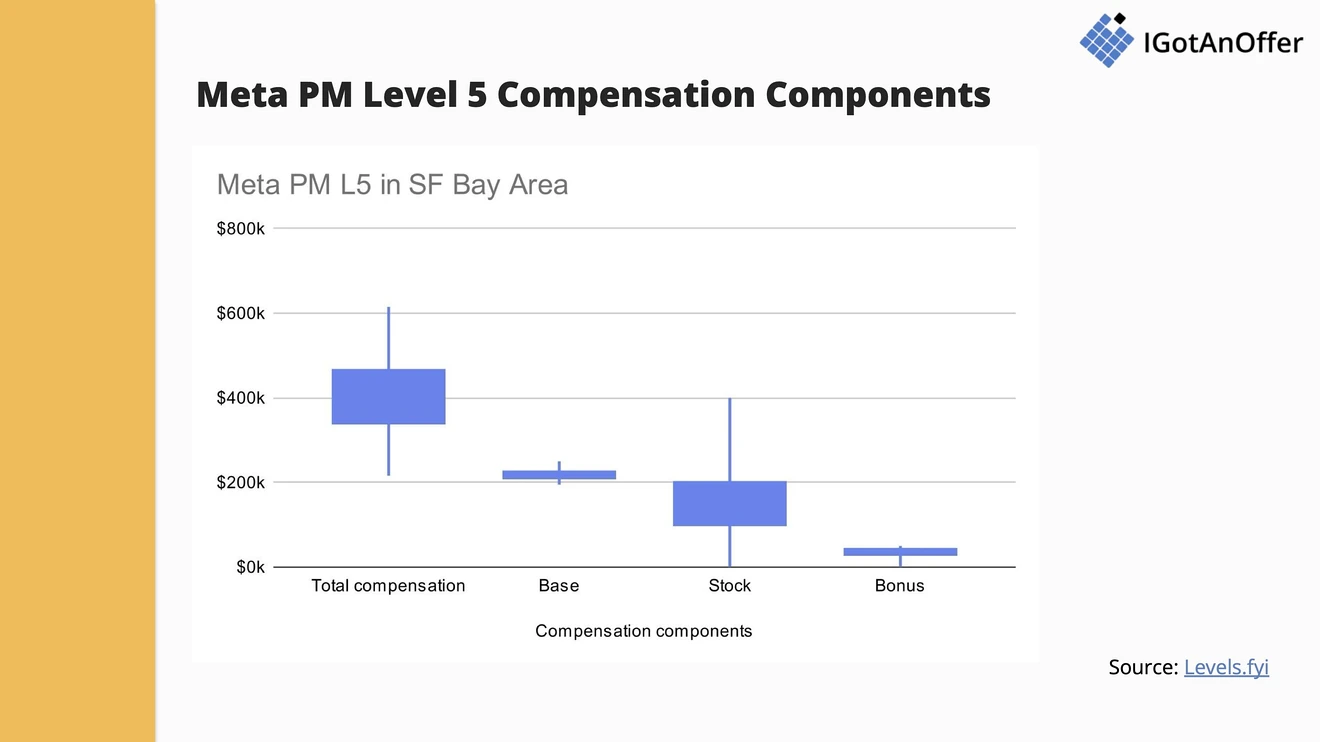
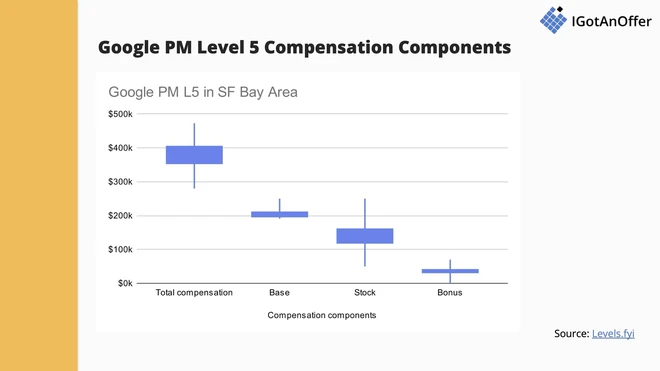
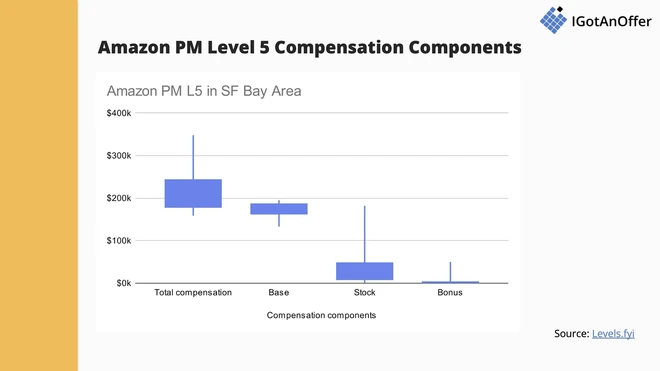
This range and variance are a great proxy for “room for negotiation”.
Now let’s take a look at each compensation component, how it works, and how negotiable it tends to be.
Note that for the following section, we’ll be using Levels.fyi data on the L5 PM (or equivalent) at the 8 companies we mentioned above, all in their SF Bay Area location.
1.1 Base salary
The base salary is the fixed amount you get paid on a regular basis. Each PM level has a base salary band that may differ per location.
The band is narrower at junior levels than at more senior levels where there's more room for negotiation.
Base salary offers for L5 PMs at top tech companies tend to be worth between $133k and $200k.
It’s common for tech recruiters to put you at the bottom or middle of the base salary band in their initial offer. Base salary bands are a lot narrower than RSU bands. You’ll be able to achieve a base increase by negotiating, but it won’t be as big as your RSU increase.
However, not all top tech companies will be easy to negotiate with in terms of base salary. Amazon is known for its firm base salary caps, and Uber’s base salary is famously tough to negotiate. Still, recruiters will expect you to negotiate, so it’s best to know the salary trends for your level and location.
1.2 Stock options (RSUs)
Most top tech companies will include RSUs in an initial PM offer and will typically be very willing to negotiate them.
That’s why the variance and range for RSUs tend to be quite large, as we’ve mentioned, worth somewhere between $10k and $400k.
In a lot of PM offer negotiations, the majority of the increase comes from RSUs getting bumped. And it’s common for RSUs to be higher than your base salary at the end of a negotiation.
The highest total compensation is often achieved by a hire who is willing to decrease their sign-on bonus to $0 in exchange for maxing out their RSUs.
1.2.1 How do RSUs work?
Different companies will have varying vesting schedules for their RSUs.
For example, Meta uses a 4-year vesting schedule in 25% increments. Here’s what percentage of your RSU grant you’ll receive every year:
- Year 1: 25%
- Year 2: 25%
- Year 3: 25%
- Year 4: 25%
Google RSUs (referred to as GSUs) used to follow the same vesting schedule. It has since shifted to 38/32/20/10 in 2024. With this new structure, here’s the percentage of your GSU grant you’ll receive every year:
- Year 1: 38%
- Year 2: 32%
- Year 3: 20%
- Year 4: 10%
The vesting cadence will vary depending on the company. Some, like Meta, Google, and DoorDash, have a quarterly cadence. Amazon has a semi-annual cadence but has also introduced a quarterly cadence for certain qualified levels.
Other companies may offer options for the type of RSUs you can get. For example, Microsoft has two RSU types: on-hire stock awards and annual stock awards. On-hire stock awards vest yearly (on your hire anniversary) over four years. Annual stock awards vest quarterly over five years.
As you can see, RSUs vary depending on the company. When negotiating, it’s best to be clear about the type of RSUs the company offers, including their vesting schedule.
1.2.2 Valuing your RSUs
There’s a lot more uncertainty around RSUs than there is around any of the other components of your product manager compensation.
Here are the two biggest factors to think about as you value your RSUs:
- Stock price fluctuations. A company’s stock could go up or down, and the value of the RSUs you’re getting is bound to change. This will have a huge impact on your actual financial outcome. Unfortunately, it isn’t something you control or predict with certainty.
- Likelihood of vesting. Although this probably isn’t on your mind right now, certain circumstances might urge you to leave the company. You might decide to resign because you don’t get on with your manager or team, or you might be fired as part of a reorg. If this happens within 4 years, then you won’t take full advantage of your grant.
It’s important that you take these aspects into account when assessing and negotiating your offer.
Unless you’re 100% comfortable with the risks described above, we recommend that you negotiate higher RSUs but also a higher base and sign-on bonus, which are more certain financial benefits.
1.3 Sign-on bonus
Unlike RSUs, a sign-on bonus (or signing bonus) is not always included in most companies’ initial offers.
A sign-on bonus is a one-time benefit that companies give as an incentive to join. There are two main ways to think about your sign-on:
- Most people think about it as a lump sum that helps cover any bonuses (e.g., performance bonus) or unvested equity you’re walking away from at your current company.
- If you’re not walking away from anything, you can look at it as a bridge between your start date and your first RSU vesting date.
Some companies, like Meta and Google, won’t offer it from the get-go, but will eventually include it if you negotiate. They may offer between $30k and $50k.
Some emerging tech companies like Uber and DoorDash include sign-on bonuses for in-demand roles, including product manager.
Amazon’s offers, on the other hand, always include a sign-on bonus. The bonus is typically split and paid for years 1 and 2, to make up for the backloaded vesting schedule.
You may notice on Levels.fyi, that some Amazon PM candidates declared their signing bonus as $0. This may be because they negotiated to max out their RSUs instead.
1.4 Performance bonus
Performance bonuses are set at the company level for your role and level and are typically not negotiable.
However, any improvement you get to your base salary will be compounded by your performance bonus. Therefore, it’s a factor you should take into consideration when negotiating your base.
Performance bonuses are not always a guaranteed component of a PM offer. Most top companies, like Meta, Google, and Microsoft, are known to give generous performance bonuses, with regular payout schedules.
These three companies in particular have a set percentage per level, and also take into account individual and company performance. So, how much you receive will be a bit unpredictable.
For example, in 2024, Microsoft promised up to a 25% performance bonus as a one-time cash award after a good fiscal year. Google announced that starting in 2026, it would boost bonuses for individuals with an Outstanding Impact rating and cut bonuses and equity for middling performers, as a way to encourage higher performance.
Amazon, on the other hand, doesn’t give performance bonuses. Instead, they give out yearly base pay increases based on your performance.
If you get your signing bonus as a lump sum in your first 30 days and leave within the year, you may be required to pay back a prorated portion of your bonus. For example, if you leave after 6 months, you’ll have to pay back 50% of your sign-on bonus.
1.5 Equity refreshers
Most companies offer equity refreshers to employees who have been working for more than 4 years and have run out of RSUs. They do this as an incentive for employees to stay.
You should ask about equity refreshers during your negotiations. Just be aware that the vast majority of recruiters will shy away from sharing any details, making it a component that’s not negotiable in practice.
Like RSUs, equity refreshers vary per company. At some, you’ll only be able to negotiate your equity refreshers once you’re up for them as a tenured employee.
Others, like Amazon and Google, won’t negotiate as their refreshers are typically management-driven.
1.6 Perks and benefits
Most top tech companies will offer health insurance, a 401 (k) match plan, relocation support, and free food in the office, amongst other things, as part of their package.
Other perks and benefits built into your package may include wellness and family benefits, education assistance, and transportation allowance. The inclusions will, of course, depend on the company. In most cases, these won’t be negotiable.
If you’ve been offered a remote or hybrid PM position, be sure to ask if your company offers support in the form of a stipend, reimbursement, or equipment.
1.7 Other add-on components
Top tech companies typically include other add-on benefits to make their offers more attractive.
On top of generous personal time-offs (PTOs), many top companies offer extended parental leaves. Others, like Meta and Uber, offer a paid 30-day sabbatical after a tenure of 5 to 8 years. Google and Microsoft offer paid volunteer days.
Other unique benefits include Amazon’s Cancer CARES program, Google’s student loan matching, and Microsoft’s hobby reimbursement.
2. Get product manager compensation benchmarks↑
Now that you know the possible components of a PM compensation package, let’s take a look at the figures.
When negotiating your base salary, RSUs, and signing bonus, you’ll want to show your recruiter that you’re aware of how much you’re worth, based on the current salary trends in your level and location.
So in this section, we’ll equip you with the figures that you can bring to the table when negotiating, based on Levels.fyi data.
2.1 Averages per PM level
Below are the average base and total compensation (including bonus and RSUs) per product manager level.
We used the Levels.fyi data for 8 different tech companies with PM roles: Meta, Google, Amazon, Uber, Microsoft, DoorDash, Walmart, and Salesforce.
In some cases, there won’t be any declared salaries for certain levels. Also, we’ve used the standard L4-L7 terminologies for the levels, though some companies may have different terms.
The figures have been arranged from the highest total compensation to the lowest.
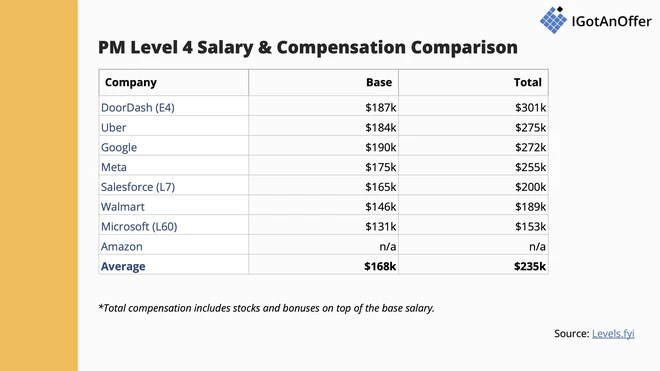
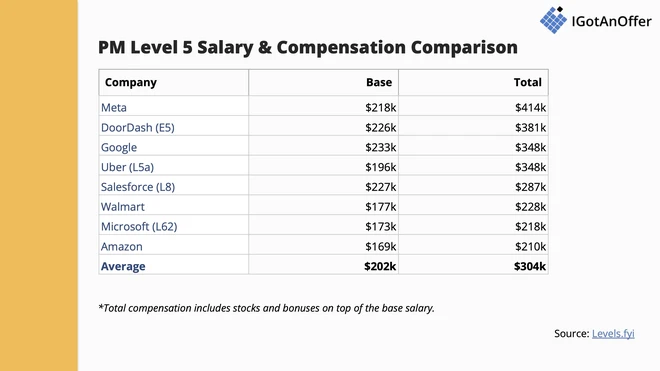
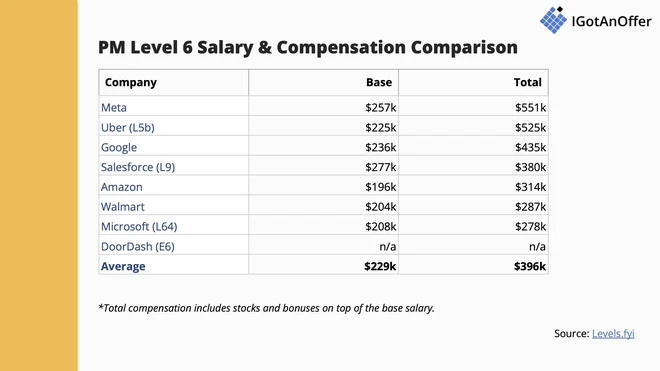
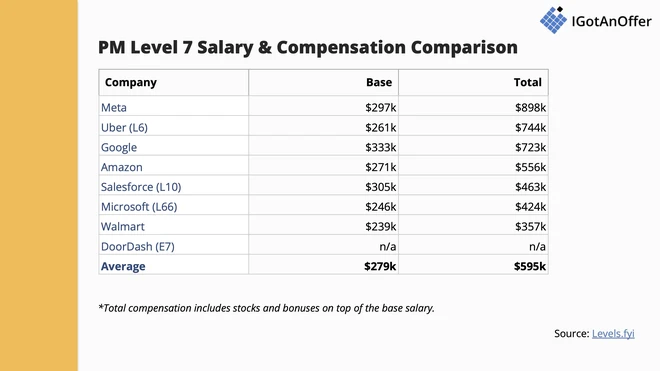
You’ll notice that more senior levels, the range for total compensation can go up drastically. This means seniority can give you more leverage to negotiate bigger bonuses and RSUs.
2.2 Level 5 PM averages by offer component
In the table below, we’ve summarized the averages of each offer component (base salary, stocks/RSUs, bonus, and total compensation) for the product manager L5 position per company in the SF Bay Area location.
These averages are based on the most recently reported data on Levels.fyi, from 2024-2025.

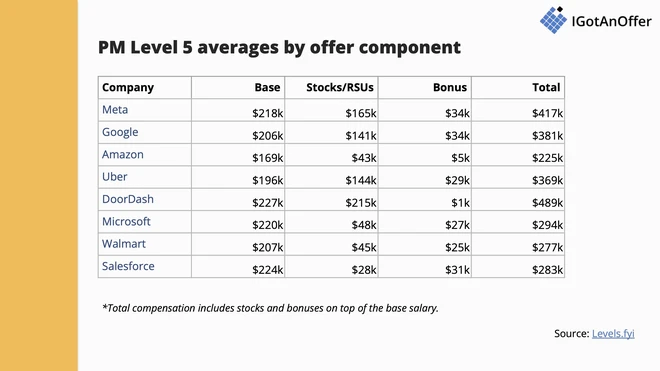
Now that you’ve seen some benchmarks for PM offers across levels and companies, let’s look at how you can use them in the next step.
3. Find weaknesses in the initial offer↑
Now that you understand the different compensation components for the product manager role, your next step should be to find weaknesses in the initial offer you receive.
We recommend breaking down your research in two steps:
- First, you should research ranges and have benchmarks for your main compensation components (base salary, sign-on, RSUs) using public data sources.
- Second, you should research the other benefits you’re being given (e.g., remote policy, time-off, etc.) and identify where they fall short compared to your current company or other companies you’re in the process with.
3.1 Research ranges and benchmarks for the main compensation components
For the main compensation components (RSUs, sign-on bonus, and base salary), you should identify ranges and benchmarks for your PM level and location. This is similar to the work we’ve shown in the previous section.
For this research, we recommend using multiple sources. Start with the benchmarks we offer, then beef up your research with figures from other sources. A few we recommend include: Levels.fyi, Glassdoor, Comparably, and Salary.com.
As you do your research, remember that there’s a time-lag between the moment offers are reported on these websites and the time at which they were actually made. In practice, this means that the ranges you will find will be lower than what’s currently being used by your company.
After doing this work, you should have a sense of how much you can ask for for each compensation component. It’s important to stay realistic as you do this exercise.
Here are two sanity checks we recommend making before settling on specific numbers you’re going to ask for.
- It’s unlikely that you’ll manage to get to the very top end of the range for all components. Broadly speaking, there are two extremes. If your aim is to maximize total compensation and you’re comfortable with the risks associated, then you could focus on maximizing your RSUs. If you’re interested in more certainty, then you could focus more on base salary and the sign-on bonus but you’re less likely to reach the top end of total compensation.
- You should try to be realistic about the skill set you bring to your company. For instance, at the time of writing, there’s great demand for PMs to be full-stack PMs with their own niches while also keeping up with the disruptions of AI. As a consequence, those are the skill sets that are most likely to achieve the highest total compensation for a given level and location.
3.2 Research the other benefits you’re given
Once you have a good grasp of total compensation ranges for your level and location you should turn your attention to the other benefits that are included in your PM offer.
You should do this by reviewing your company’s benefits documentation. The objective of this exercise is to highlight differences in the benefits offered by your prospective company and other companies (including your current employer).
Once you’ve identified areas where your initial offer falls short, you should look to confirm your understanding with your recruiter.
Here are three examples of areas you could ask your recruiter about.
Discounted stock-purchase program
- Goal: At the time of writing, companies like Meta, Google, Amazon, and DoorDash do not provide this benefit (also referred to as employee stock purchase plan or ESPP), whereas other tech companies do.
- Confirm with your recruiter: My understanding is that the company does not provide a discounted stock-purchase program/ESPP? Is this correct or did I miss this information somewhere?
Remote policy
- Goal: At the time of writing, employees at Meta, Google, Uber and Microsoft have to spend 3 days per week in the office. Amazon and Walmart have mandated a full return-to-office policy. This might be less flexible than your current company.
- Question: My understanding is that the company’s employees have to spend 3 days/5 days per week in the office. Is that correct or does a different remote policy apply to this role?
Vacations/PTO
- Goal: At the time of writing, most companies offer a minimum of 20 paid days off per year, with the possibility of increased days based on tenure. Some companies like Meta don’t distinguish vacation days from sick leaves, while others like Walmart do. Your current company might have a more generous PTO policy.
- Question: My understanding is that the company’s employees have 21 paid days off per year. Is that correct or is the policy different for this role?
Once you’ve identified the main weaknesses in your initial job offer, you’re ready to craft a counter-offer email.
Can you lose your PM job offer by negotiating?
No, as long as you negotiate politely and respectfully, you won't lose your PM job offer.
According to Alex (former Pathrise salary negotiation consultant), it is rare for a candidate to get their offer rescinded.
“[The company has] dedicated a ton of time and resources to sourcing and interviewing the right candidate, and they’re giving you an offer because they believe you are the one.”
He adds that there are only two cases he’s seen where offers have been rescinded:
- They felt like you would be a liability. a.k.a., you were disrespectful or raised a big red flag after receiving the offer.
- There’s a culture problem at their company.
“If they rescind an offer simply for negotiating, I promise you, you are dodging a bullet,” Alex says.
If you do your research well and are thoughtful about what you ask for, the worst that can happen is that your recruiter doesn't budge and says that the initial offer they made you is a final offer that's non-negotiable.
4. Send a counter-offer email to your recruiter↑
4.1 Consider setting a “walk-away” number
How will you know if you’ve negotiated successfully?
Before starting a negotiation, it can be helpful to write down your “walk-away” number. Your “walk-away” number is the minimum number or set of conditions you’re willing to accept.
If you manage to negotiate an offer that’s above that number, you’ll accept it. If you don’t, then you’ll walk away and stay at your current company, or continue interviewing.
That number and your set of conditions are subjective and result from a lot of different factors including: the research you’ve done, your other options, other personal circumstances, etc.
Having that number in mind during the negotiation will enable you to keep a cold head and to know when to accept the offer or move on.
There are many ways to make a counter-offer. Here are two common ones we recommend considering:
Share your walk-away number with your recruiter
Let your recruiter know upfront that’s the minimum you’re willing to accept
The main benefit of this approach is its simplicity. It minimizes back and forth and also makes it clear to your recruiter by how much the initial offer needs to be increased to bring you on board.
Its downside is that you might not maximize your total compensation because your walk-away number might be lower than the maximum offer the company could be willing to make you. You also obviously can’t use that approach if the initial offer you received is already higher than your walk-away.
Start negotiations with a higher number
Starting the negotiation with a higher number than your walk-away will help you leave more room for negotiation.
The main benefit of this approach is that it has more upside than the first one. You’re more likely to maximize total compensation using it.
Its downside is that it will involve more questions, pushback, and back and forth with your recruiter. In other words, it’s more work and discomfort to go through.
If you pick the second approach, working with a seasoned job offer negotiator can help a lot.
4.2 Write your counter-offer email
Whatever approach you pick, we recommend sending an email containing your counter-offer, rather than making a call to the recruiter for a few different reasons.
Why email instead of a call? Here are two reasons:
- An email puts you in complete control of what you’re communicating and so you can’t be derailed by questions the recruiter throws at you.
- Your recruiter will be able to easily forward that email to their team to review and increase your offer.
Here are example email templates you could use.
Non-negotiable counter-offer email template
Hi X,
Thanks again for taking the time to interview me over the past few weeks and for making me an offer to join the company. I’m really excited about joining and I’m confident I can make a positive impact as a product manager.
I took the time to review your initial offer and to carry out research to better understand typical compensation packages for my skill set, level and location. And I also reflected on my personal situation and the different things I’d be walking away from (e.g. $xk in performance bonus and $yk in unvested equity).
All things considered, the minimum compensation I’d be willing to accept to join is as follows: Base salary: $xk; Sign-on: $xk and RSUs: $xk.
I realize these are higher numbers than you initially shared. But below these numbers, my personal preference is to stay at my current company and/or to continue my job search.
As I mentioned in my interviews, I’m really excited to join the company because [reason 1] and [reason 2] and I’m really hoping your compensation team will be able to match the offer suggested above.
I’m available to jump on the phone to answer any questions you might have.
All the best
X
Flexible counter-offer email template
Hi X
Thanks again for taking the time to interview me over the past few weeks and for making me an offer to join the company. I’m really excited about joining, and I’m confident I can make a positive impact as a product manager.
I took the time to review compensation ranges for my role, level, and location. Based on that research, I would like to ask for the offer to be moved closer to the following numbers: Base salary: $xk; Sign-on: $xk and RSUs: $xk.
In addition, I wanted to stress that moving away from my current company would mean making the following trade-offs for me:
- I’d be walking away from $xk in performance bonus and $xk in unvested equity
- My current company also provides ABC benefits that I would lose by moving over
As I mentioned in my interviews, I’m really excited to join the company because [reason 1] and [reason 2], and I’m really hoping your compensation team will be able to match the offer suggested above.
If that makes things easier for you, I’m more than happy to jump on the phone to talk about these different points with you.
Best regards
X
5. Hold your ground↑
5.1. Answer your recruiter's questions
If your PM skill set is in high demand, or if you’ve done extremely well in the interviews, then your recruiter might reply with an improved offer rapidly.
But in a lot of cases, it will take a few phone calls and emails to wrap up the negotiation.
A very important point to remember as you negotiate is that your recruiter does not make the final decision on the compensation package - the central compensation team does.
If your recruiter pushes back on your request, your aim is therefore to convince them to talk to their compensation team to review the numbers.
Your recruiter might ask you questions such as "Are you sure about your compensation data?" or "Are you really that excited about working for the company?" when you negotiate.
If they do so, you should simply explain again why you're really excited to join and politely ask them to consider your request to get an updated offer from the compensation team.
Ultimately, if your recruiter knows there’s room for negotiation, they’ll eventually take things back to their team for an improved offer.
If they know there really isn't any room for negotiation, then they'll make it clear that the offer you're looking at is the final offer and will even sometimes give you a deadline to accept it.
Can you negotiate without a competing offer?
While having a competing offer gives you more leverage to negotiate, not having one shouldn’t stop you from negotiating. After all, most, if not all, companies always start with a lowball offer.
If you’re walking away from a current job to pursue the new role, you can consider what you’re getting at your current company as a competing offer. Moving from one company to another means you’re seeking to level up, so anything you’re offered at your new company should be better than what you’re currently getting.
Say you’re a fresh graduate. It’s true that you may not have as much leverage as someone 10 years into their career, but this doesn’t mean you have 0. They’re hiring you for a reason.
Alex (ex-Pathrise salary negotiation consultant) says, “Find out that reason in the interview process and talk about it when you negotiate your offer.”
You can get creative with the ways you create leverage, but you’ll want to think about it in these three ways:
- Positive leverage: what they gain by hiring you (your unique value)
- Negative leverage: what they lose by not hiring you (competing offers, other interviews)
- Normative leverage: objective criteria for negotiation (agree on a source of truth for your market research)
5.2 Take into account how "hot" the overall hiring market is
One final important consideration as you negotiate with your prospective company is how hot the overall market is when you're negotiating.
For instance, at the time of writing this article, there are currently 38,000 PM job posts on LinkedIn in the US alone. However, the competition is stiff, with every single post attracting 250 candidates on average.
With so many highly qualified candidates to choose from, it seems that you won’t have any leverage when negotiating. This doesn't mean you should not negotiate; it just means that the raises obtained by negotiating are lower on average.
Check out the video below where salary negotiation coach Annie breaks down 10 rules of salary negotiation.
Salary negotiation resources ↑
We also recommend the resources below for your further salary negotiation preparation.
You can learn more from our job offer negotiation guides:
- Best salary negotiation services (2025)
- Meta job offer negotiation guide
- Google job offer negotiation guide
- Apple job offer negotiation guide
- 10 Rules of Salary Negotiation
Other salary negotiation resources:
- Ultimate Negotiation Guide (American Negotiation Institute)
- 15 Rules for Negotiating a Job Offer (Harvard Business Review)
- How to Negotiate Your Salary in the Age of Pay Transparency Laws (Harvard Business Review)
- O*net (Department of Labor-sponsored website that provides a comprehensive look at the skills required for specific jobs across all industries, plus median pay per job)
- H-1B Data (For foreign nationals working for U.S. employers)
- Payscale (Salary comparison website)
- Glassdoor (Salary comparison website)
Get support from a professional negotiator↑
Our coaching team has run thousands of salary negotiations as recruiters and hiring managers. They negotiate daily and are therefore extremely comfortable with the process.
A negotiation done well should usually yield $10k+ to $100k+ in increase, depending on your level and location. So spending $150 to $500 on getting help from a coach has a huge ROI (at least 10x).
Here’s what our coaching can help you with:
- Help you understand how "hot" the overall hiring market is right now
- Finding the weaknesses in your initial offer
- Determining what a reasonable total compensation is for you
- Practicing mock negotiations over the phone
-
Giving you advice in situations we haven’t covered above















